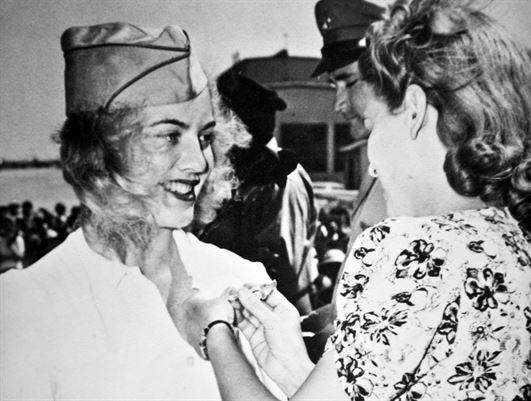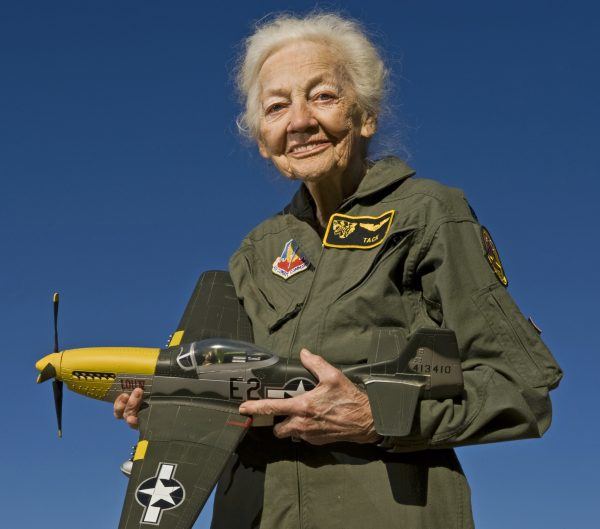“Thank you for paving the way for today’s women military pilots.”
Betty Tackaberry Blake, “Tack” for short, was a member of the first graduating class of the Women’s Air Force Service Pilot (WASP) aviation training class during World War II (Class 43-W-1 ). Until her death on April 9, 2015, at the age of 94, she was the last known member of the first graduating WASP class.
“I feel very blessed to have been there at the beginning and gotten in,” said Blake in an interview with Airman Magazine before her death. “It’s been an exciting life for a little kid who grew up on the beach in Honolulu.”
Betty was born October 29, 1920, in Honolulu, Hawaii. She “grew up with two brothers in a neighborhood filled with boys,” so it was only natural to become quite the tomboy. In high school, she was the catcher on the boys’ baseball team. At an early age, she began to read all sorts of aviation books about pilots.
In 1934, at age 14, Betty’s father took her to a lecture at the University of Hawaii, where she met her inspiration and role model, Amelia Earhart. This was before her historic 1935 flight from Honolulu to Oakland, California. Already bitten by the aviation bug, she was completely hooked when she saw the twin-engine Beechcraft that Earhart would pilot to California.
“She was very excited to know I was learning to fly,” Blake said. “She told me to keep going and do something exciting and show that women could fly. She had a lot of people fighting against her who didn’t think women could do it.”
Unwavering in her desire to fly, Blake located a school near the airport, and the owner gave her a chance. In exchange for office work, she received free flying lessons with instructors but was not old enough to fly solo without her parents’ permission.
In a 2006 interview, she reminisced, “I didn’t dare tell my father. He didn’t know I was going to the airport. Everybody’s tan in Honolulu ’cause you’re at the beach so much. I would tell him I was going to the beach and I would hitch rides with anybody that would take me up to the airport, which was ten miles away, near Pearl Harbor.”
For two years, she went “to the beach,” accumulating enough flying hours to fly solo. Eventually, she had to tell her father. When she received her private license, she flew open-cockpit biplanes, hopping islands with one or two passengers. She went to the Civilian Pilot Training (CPT) at the University of Hawaii and was the first female in the program.
Pearl Harbor Attacked – December 7, 1941
The following was written by Betty just three years before her death. In her own narrative she described what happened before and after Pearl Harbor (courtesy of dodlive.mil):
We were all so spoiled. We were having fun every night, and suddenly it all stopped. I was at a party with this ensign at the officers club at Pearl Harbor on Dec. 6. I’d just had a birthday in October, so the ensigns and people on the ships invited me to the officers club that night to celebrate. My family didn’t drink, so I’d never had a drink in my life. The next morning, when Pearl Harbor happened, I was in bed with the worst hangover.
Robert Tackaberry and I had been to the party, and it was a long drive from Pearl Harbor back to where I lived. I was the only one with a car because he was based on the ship, and my father didn’t want me driving home on that road because there were so many accidents on a Saturday night.
His cabin on the California was below the water line, and they dropped a bomb right in the water beside the ship. His roommate was asleep, and it killed him. So my father always reminded my future husband he’d saved his life.
We lived on a hill overlooking Honolulu and the water, from Diamond Head to Pearl Harbor. That morning, my younger brothers woke me up and we all went out to the balcony of my house to watch all these planes coming over the mountain behind us going toward the ocean. When the planes went over, they were [Mitsibishi A6M] Zeroes, but they looked like AT-6s. They had big orange suns painted on the bottom of the wings. Then we saw them as they started diving into the ocean in front of us. Their machine guns started going off, and you could see the bullets hitting the water and bouncing up.
The secretaries for the officers were all wives of military personnel, and after Pearl Harbor, they started shipping them by plane to the West Coast. I had a cousin who was skipper of a submarine in Pearl Harbor that day, which fortunately wasn’t hit. He called our house and said, you’ve got to take a job at Pearl Harbor. They’re desperate for people who can type. The very next day after Pearl Harbor, I went to work for the captain of the yard.
It was often after dark when I drove home, which was a 15-mile drive. They covered your lights on your car with blue cellophane, which left a little hole in the middle that wasn’t covered about the size of a 50-cent piece. So you could barely see, and I had to drive after dark most of the time I worked at the base. I’d get home, and we’d go out on the balcony at night and look out toward the beach and see these little flickers of lights of the people who had permits to drive at night.
One of the First
“If you hadn’t been successful, we wouldn’t be doing what we’re doing today.”
Her dream of flying never wavered. She applied to be a pilot and was accepted in the “first” training class at Howard Hughes Airfield (later renamed Ellington Field) in Houston, Texas. She began training with “38 women pilots on Nov. 16, 1942, but only 23 graduated on April 24, 1943.”

“They weren’t known as WASPs until the merging of the Women’s Flying Training Detachment and Women’s Auxiliary Ferrying Squadron in 1943. The WASPs flew aircraft ferrying and delivery missions, towed aerial targets, and participated in flight testing and evaluation of advanced jet and rocket-powered aircraft. The women replaced male pilots so they could fill combat roles.
“We were the guinea pig class,” she said, referring to the first WASP class. “We were the experiment because they didn’t think we’d be able to do it. They watched us like hawks to see if we were going to make it.”
“There was some discussion of using WASP pilots as co-pilots for overseas flights, but the war in Europe ended before it could happen,” she said. “So, I didn’t get checked out in a lot more planes that I would’ve liked to have flown because they brought all the men pilots back and didn’t need us anymore.”
“They gave us three days’ notice, and it was, ‘Goodbye, girls.’”
One airplane remained her favorite. “The P-51 (Mustang) was definitely my favorite,” she said. “Whenever one goes overhead, and there are still a few of them flying around, I hear that sound and instantly know it’s a P-51. It was reliable. I liked the engine, and I just felt safer in it than anything else.”

Many years later, at another Women’s History Month celebration, a young female pilot showed her then 91-year-old guest the F-16 Fighting Falcon she flew at Luke Air Force Base, Arizona. The younger pilot thanked Betty “Tack” Blake several times as she talked about her job, so Blake finally asked the young captain why she was thanking her.
“Because you started it,” the captain said. “If you hadn’t been successful, we wouldn’t be doing what we’re doing today.”
Rest in Peace, Betty “Tack” Blake. Thank you for paving the way for today’s women military pilots.
















